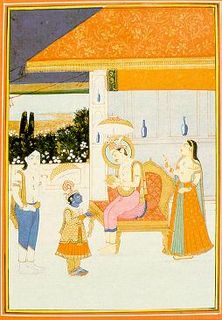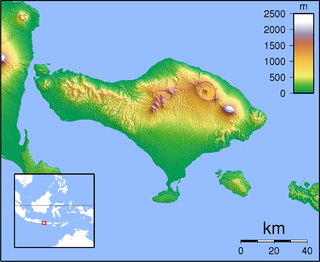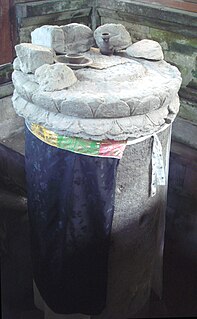
Mahabali is also known as Bali or Māveli or "Vairochana" was a benevolent Asura King, and the grandson of Prahlada in Indian scriptures. The festival of Onam is celebrated in Kerala to mark his yearly homecoming after being sent down to the underworld Sutala by Vamana, a dwarf and the fifth incarnation avatar of Vishnu. The government of Kerala declared Onam as the ‘State Festival’ of Kerala in 1960.

The Balinese people are an Austronesian ethnic group native to the Indonesian island of Bali. The Balinese population of 4.2 million live mostly on the island of Bali, making up 89% of the island's population. There are also significant populations on the island of Lombok and in the easternmost regions of Java.
"Bali Ha'i", also spelled "Bali Hai", is a show tune from the 1949 Rodgers and Hammerstein musical South Pacific. The name refers to a mystical island, visible on the horizon but not reachable, and was originally inspired by the sight of Ambae island from neighboring Espiritu Santo in Vanuatu, where author James Michener was stationed in World War II.
Thiruvidandai suburban village located in South Chennai, about 19 kilometres south of Thiruvanmiyur, and 4 kilometres distant from Covelong on the East Coast Road in the Indian state of Tamil Nadu. The village derives its name from the Nithyakalyana Perumal temple and its history is centered on the temple.

Danghyang Nirartha, also known as Pedanda Shakti Wawu Rauh, was a Shaivite religious figure in Bali and a Hindu traveler during the 16th century. He was the founder of the Shaivite priesthood in Bali.

Puputan is a Balinese term for a mass ritual suicide in preference to facing the humiliation of surrender. Notable puputans in the history of Bali occurred in 1906 and 1908, when the Balinese were being subjugated by the Dutch.

Lieutenant Colonel I Gusti Ngurah Rai was an Indonesian National Hero who commanded Indonesian forces in Bali against the Dutch during the Indonesian War of Independence. He was killed in the Battle of Margarana.

The Bali Aga, Baliaga or Bali Mula are the indigenous people of Bali, predominantly located in the eastern part of the island, in Karangasem. They can also be found in north-western and central regions. Bali Aga people that are referred to as Bali Pergunungan are those that are located at Trunyan village. For the Trunyan Bali Aga people, the term Bali Aga is regarded as an insult with an additional meaning of "the mountain people that are fools"; therefore, they prefer the term Bali Mula instead.

The Dutch intervention in Bali in 1906 was a Dutch military intervention in Bali as part of the Dutch colonial suppression, killing over 1,000 people, most of whom were civilians. It was part of the Dutch campaign for the suppression of most of the Netherlands East-Indies. The campaign killed the Balinese rulers of Badung and their wives and children, as well as destroying the southern Bali kingdoms of Badung and Tabanan and weakening the kingdom of Klungkung. It was the sixth Dutch military intervention in Bali.

The history of Bali covers a period from the Paleolithic to the present, and is characterized by migrations of people and cultures from other parts of Asia. In the 16th century, the history of Bali started to be marked by Western influence with the arrival of Europeans, to become, after a long and difficult colonial period under the Dutch, an example of the preservation of traditional cultures and a key tourist destination.

Sri Kesari Warmadewa was the first king of Bali to leave a written inscription. He authored the inscription on the 914 CE Belanjong pillar in southern Sanur. The inscription It is written in both the Indian Sanskrit language and Old Balinese language, using two script, the Nagari script and the Old Balinese script. The pillar testifies to the connections of Bali with the Sanjaya Dynasty in Central Java. It is dated according to the Indian Saka calendar.

The Belanjong pillar, also Blanjong pillar or Blanjong inscription, is a pillar established in 914 CE in the harbour of Belanjong, in the southern area of Sanur in Bali.

Jayapangus was a king of Bali. He is known through his inscriptions, some of them related to taxes.

Bali Pratipadā is the fourth day of Deepavali (Diwali), the Hindu festival of lights. It is celebrated in honour of the notional return of the (Daitya)-king Bali to earth. Bali Padyami falls in the Gregorian calendar months October–November. It is the first day of the Hindu month Kartika and is the first day of the bright lunar fortnight in the month. It is also called the Akashadipa. It is celebrated as the first day of the Vikram Samvat calendar, in Western India. It is celebrated as New Year Day in Gujarat and marks beginning of New Vikram Samvat Year.

The Dutch intervention in Northern Bali in 1846 was the first in a long series of Dutch military interventions on Bali island, until total control was achieved with the Dutch intervention in Bali in 1908. The Dutch used as a pretext Balinese salvage claims over shipwrecks, which were customary to the Balinese, but unacceptable to the Dutch.
I Gusti Ketut Jelantik (-1849) was a Balinese Prime Minister of the state of Buleleng, who resisted the imposition of Dutch treaties.

The Kingdom of Bali was a series of Hindu-Buddhist kingdoms that once ruled some parts of the volcanic island of Bali, in Lesser Sunda Islands, Indonesia. With a history of native Balinese kingship spanning from the early 10th to early 20th centuries, Balinese kingdoms demonstrated sophisticated Balinese court culture where native elements of spirit and ancestral reverence combined with Hindu influences – adopted from India through ancient Java intermediary – flourished, enriched and shaped the Balinese culture.
Queen Arjayadengjayaketana of Bali was a ruler of that island in 1200.

Pura Dalem Segara Madhu also known as Pura Dalem Jagaraga is a northern Balinese Hindu temple or pura located in the village of Jagaraga, Buleleng in northern Bali. It is situated abount 11 km east of Singaraja. The village of Jagaraga is known historically as the place where the Dutch colonial government witnesses puputan or Balinese mass-suicide following their military attack on the kingdom of Bali in 1849. Pura Dalem Segara Madhu is known for its intensive wall decoration typical of northern Balinese architecture and for its unique western-influenced relief e.g. motifs of early 20th-century airplanes and automobiles.















